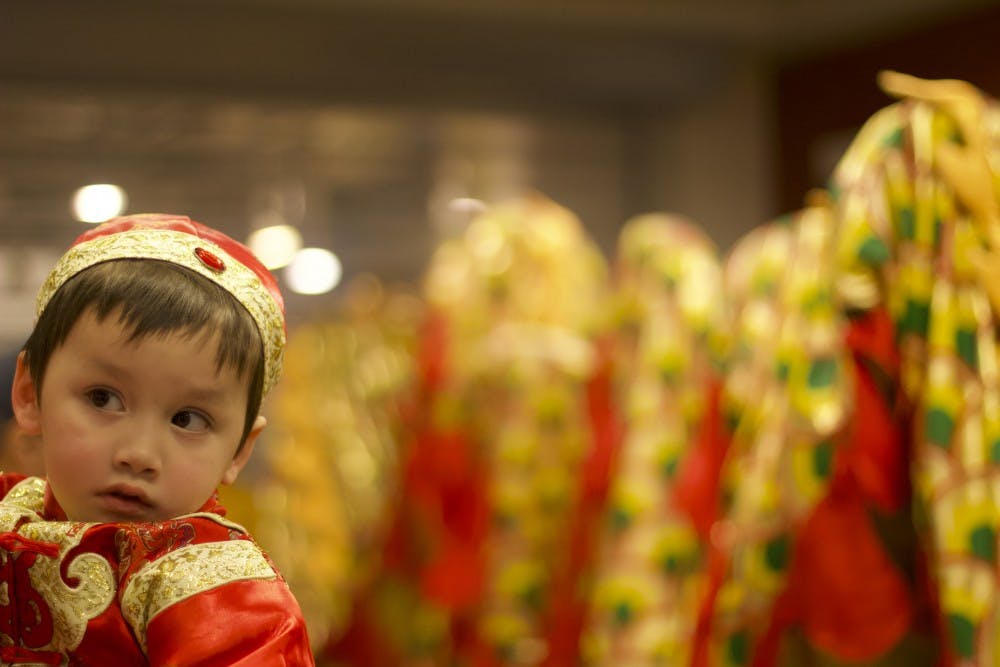A red and gold dragon snakes through the deli meats and crêperies of Reading Terminal Market.
Costumed lions snap their jaws at little children who scream happily and take cover in their parents arms. Red paper lanterns hang overhead. Despite the playful shrieks and beating drums that accompany the parade from the next aisle over, it is impossible to hear over the Dutch being spoken by the Amish workers at the market counters and the locals out for lunch. Slowly, the parade ushering in the Chinese Lunar New Year makes its way through the crowd.
The performers are teenagers, all part of a group called the Philadelphia Suns, a nonprofit centered on organizing community to aid with youth development. Originally formed as a youth basketball group in 1972, they have since branched out to include professional lion dancing. “It’s a really good experience," says Allen Lin, a sixteen year old from Chinatown, Philadelphia. “It means to bring good luck around the Chinese New Year." In Chinese culture, the lion is considered auspicious and mythic, as before the Han Dynasty when lions were imported via the Silk Road, they were the stuff of legend.
The energy changes as Matt Zhang enters. Wearing a white uniform with an embroidered black–and–white symbol of yin and yang on the front, Matt entertains the crowds with Tai Chi. He is eager to pose for the camera, smoothly transitioning from a proud grin to a placid stare. This duality appears in his personal life as well. Originally from Shaanxi Province, China, Zhang came to the States to teach martial arts. He moved to Philadelphia after marrying his wife, and now works in technology as well as being CEO of the East West IT Services and the head instructor of the Tai Chi, Kung Fu, Qi Gong and self–defense classes. His philosophy, he says, is “to live a happy and healthy physical and mental life.”
Reading Terminal Market is an ideal venue, as markets often host Chinese New Year Celebrations.
Parades, lion dances, and dragon dances are traditional. Tai Chi demonstrations are less so. In Philadelphia, they serve as demonstrations of culture, to educate everyone on the Chinese New Year.
The festivities at Reading Terminal Market offer a glimpse into Chinese culture, albeit an Americanized version. For example, at open air markets in China, traditional Spring Festival couplets, or Chunlian, are sold. Written in black or gold ink on red paper, a color which symbolizes joy and good fortune, Chunlian are pasted around door frames. In Philadelphia, good luck sayings are printed on red paper and handed out to spectators.
These reminders of luck, health, and happiness appear in the Bingqing Peng’s brush strokes. Peng is a calligrapher who has lived in America for fifteen years, after moving from Zhejiang, China. Every week he teaches his art to senior citizens in Chinatown. Although he can’t speak enough English for an interview, a girl named Amy helped translate, saying “Today is the Chinese New Year so they wanted to celebrate with these other people and feel happy.” Peng does this by inscribing traditional phrases onto strips of reds paper. Some of the most popular phrases, according to Amy, are “Wish you wealth and prosperity”, and “May all your wishes come true.” Donations are welcome, but the happiness they spread is free.
The Chinese New Year incorporates much more art than a three hour festival can encompass. After all, the celebration lasts fifteen days and has endured for thousands of years. Imperial performances, like that of the emperor's wife, are staged. Firecrackers are set off, symbolizing an ancient legend where Chinese villagers burned bamboo to ward off a monster terrorizing the locals. Lanterns in both traditional red and whimsical shapes are hung and lit because the Lantern Festival falls at the end of the New Year celebration period.
While Reading Terminal Market may not capture the extent of the arts of the Chinese New Year and the crowds there ebb and flow, the energy remains hopeful and boisterous.







